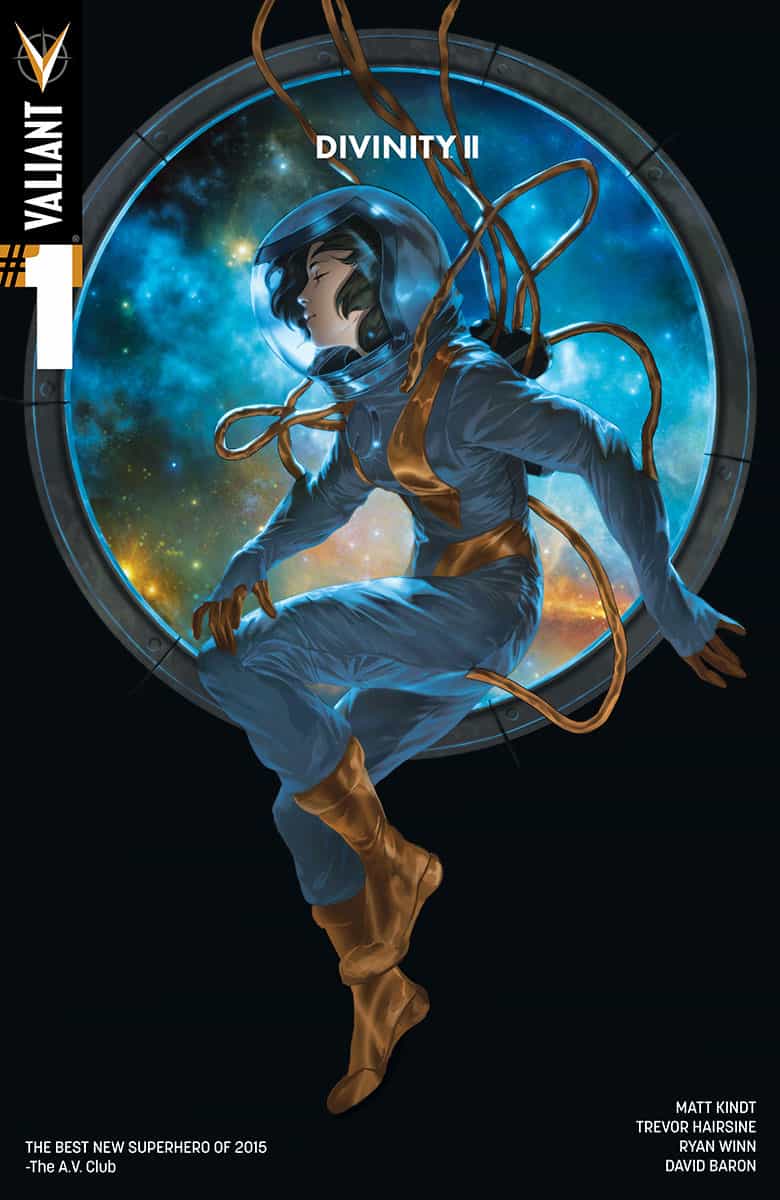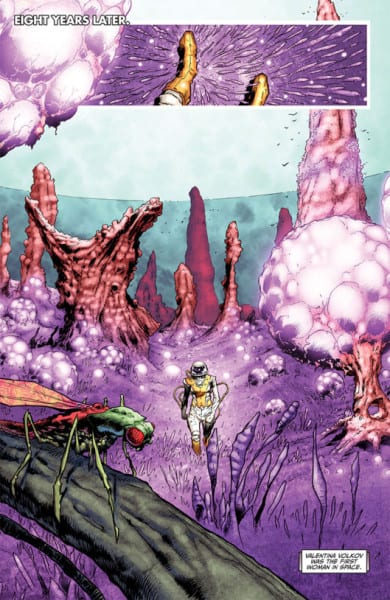
Written by Matt Kindt
Penciled by Trevor Hairsine
Inked by Ryan Winn
Coloured by David Baron
Lettered by Dave Lanphear
Published by Valiant Entertainment
Divinity was easily one of the best things released by Valiant in their entire history and was one of the best mini-series in comics last year. Bringing the exact same creative team back for this second series entitled Divinity II is very exciting indeed. The first series told the tale of Abram Adams, one of three individuals sent by the Soviet Union during the Cold War while the country competed with the United States during a race to space. Adams’s encounter with an unknown place gave him enhanced abilities and left his fellow cosmonauts behind to return to Earth. Divinity II focuses on what happened to the other two members of the team: Valentina Volkov and Kazmir.
Valentina and Kazmir find themselves on the surface of what they call ‘The Unknown’: its purple fields and pink glowing orbs making it look like a hyper-psychedelic version of The Lorax. Left behind by Abram after he got his powers, the two must figure out what to do while stranded on this mysterious environment. Intercutting with the present, Valentina’s past is revealed as she is retrieved from the streets of the U.S.S.R. by the eventual project coordinator of the space program. She is brought up under the Communist ideology, understanding the importance of sacrificing oneself for the state while sharing in the economic struggles.
 Matt Kindt picks up the cinematic approach to his storytelling right from Divinity. He does a great job at balancing the two time frames to space out the information of Valentina’s past and the present, to show how close to her heart she holds the ideology of the Soviet Union. The approach to the art style as well, paired with the flow of the script, reinforces how cinematic the comic feels. The actions in particular frames flow into similar actions between the time frames, making the jump in time feel more seamless. There is a balanced choice in using tight, close frames to accentuate the drastic, frustrated emotions or nuanced, somber moments with wider compositions to capture the vibrant, colourful alien surroundings.
Matt Kindt picks up the cinematic approach to his storytelling right from Divinity. He does a great job at balancing the two time frames to space out the information of Valentina’s past and the present, to show how close to her heart she holds the ideology of the Soviet Union. The approach to the art style as well, paired with the flow of the script, reinforces how cinematic the comic feels. The actions in particular frames flow into similar actions between the time frames, making the jump in time feel more seamless. There is a balanced choice in using tight, close frames to accentuate the drastic, frustrated emotions or nuanced, somber moments with wider compositions to capture the vibrant, colourful alien surroundings.
Trevor Hairsine’s pencils really capture the stoic, composed and calm nature of Valentina. Even from her youth, she withholds emotion, making her body very tight and face very flat, only to break out momentarily when dealing with some over-playful, testosterone fueled men while training in the space program. Kazmir, in comparison, is borderline manic with his fearful, desperate and exaggerated motions as he believes their death is imminent and will never see their home again. Just as Hairsine did with Divinity, his eyes really emphasize the emotion that is being conveyed. Ryan Winn adds some detail to the line work with some textured inks that add dreariness to the flashback sequences and heighten the tension through bold shadows upon the spacesuits on the alien landscape.
David Baron’s colours are another added solid stylistic telling of the differences in tone between  the two time frames. The past in the Soviet Union is more somber through greys and low-toned yellows and greens compared to the vibrant, bright turquoise, purple and pinks that really make the ‘The Unknown’ feel unsettling and grotesque. There are some really great moments, and particular frames, that are subtle, but showcase each of the creative team’s ability to be just as great during quieter moments as they are during the bigger revelations. The importance of pacing and weighing emotion becomes very important during these character moments through the placing of the text through letterer Dave Lanphear, allowing for a proper absorption of all parts to the comic form. One frame, after Valentina’s stepmother passes away, has her and her stepparents all in a black silhouette (a consistent composition choice) with only a single, subtle glowing yellow; its like the moment is being ingrained as a memory she will never forget.
the two time frames. The past in the Soviet Union is more somber through greys and low-toned yellows and greens compared to the vibrant, bright turquoise, purple and pinks that really make the ‘The Unknown’ feel unsettling and grotesque. There are some really great moments, and particular frames, that are subtle, but showcase each of the creative team’s ability to be just as great during quieter moments as they are during the bigger revelations. The importance of pacing and weighing emotion becomes very important during these character moments through the placing of the text through letterer Dave Lanphear, allowing for a proper absorption of all parts to the comic form. One frame, after Valentina’s stepmother passes away, has her and her stepparents all in a black silhouette (a consistent composition choice) with only a single, subtle glowing yellow; its like the moment is being ingrained as a memory she will never forget.
It is only the first issue of four, but Divinity II has presented a very interesting premise that is looking to go in quite the different direction from its predecessor. As judging by the final few pages, this series will be taking more of an alternate perspective that includes some relevant, poignant politics with the heated tensions amongst Russia and their neighbours. The impact of the past on the present, or the ignorance to it, would be a key aspect to what drove the reconstitution of the Soviet Union into the Russian Federation. The irony in history repeating itself, even if the politics appear different, continues not only in Russia, but out in the west as well. This contrast is sure to persist, especially if Abram makes an appearance (*crosses fingers*).
Memories of the past are something that has moulded Valentina into the person she has become. Kazmir asks Valentina about the necklace he has always seen her wear, wondering where she got it from. Valentina can’t quite remember where or when she got the necklace from, yet she acknowledges its importance to her childhood. Memories of the past are often kept within objects like Valentina’s necklace and will play an interesting part in the direction that Valentina’s journey is taking. The danger of living in the past can affect ones acceptance of changes occurring around the world and is sure to be an intriguing aspect on the decisions Valentina makes as Divinity II continues.


